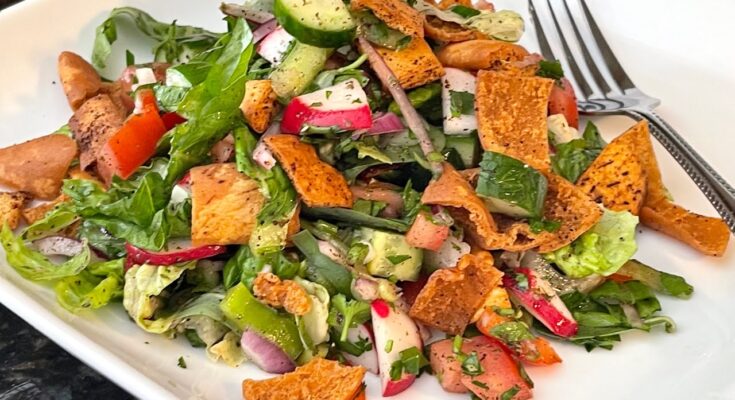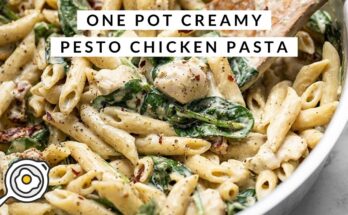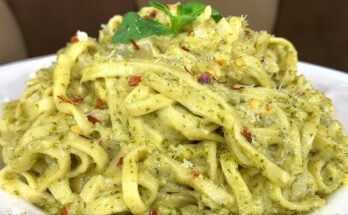Fattoush Salad Recipe: Fattoush is a traditional Middle Eastern salad that’s as colorful as it is flavorful. It’s a beautiful medley of chopped fresh vegetables combined with crispy pieces of pita bread and drizzled with a tangy, herb-rich dressing. Unlike the typical Western salad, fattoush brings together freshness and crunch in a uniquely satisfying way. At the heart of it lies sumac, a tangy spice that elevates its flavor profile and sets it apart from other salads. The unique use of toasted or fried pita makes it both hearty and refreshing—perfect as a side or a light main course.
Origin and Cultural Significance
Fattoush hails from the Levant region, encompassing Lebanon, Syria, Jordan, and Palestine. It’s deeply embedded in Levantine cuisine and is commonly enjoyed during family meals, especially in the summer. Traditionally, it was a way for households to use up stale pita bread—nothing goes to waste in the Middle Eastern kitchen. Over time, it has become an iconic dish representing hospitality, frugality, and the use of seasonal produce. In many households, fattoush isn’t just a salad—it’s a celebration of heritage and a beloved dish that brings generations together at the dinner table.
Key Ingredients in Fattoush
Fresh Vegetables
The backbone of any good fattoush is the selection of fresh, crunchy vegetables. Typical ingredients include:
- Romaine lettuce
- Cucumbers
- Tomatoes
- Radishes
- Green onions
- Parsley and mint
Each vegetable plays a vital role in adding layers of texture and freshness. Romaine provides a crisp base, cucumbers add coolness, while tomatoes bring a juicy bite. Radishes offer a peppery kick that cuts through the richness of the dressing and fried pita. Fresh parsley and mint elevate the whole dish with their aromatic fragrance.
Fried Pita Bread
One of the most distinctive elements of fattoush is the pita bread—cut into small pieces and either fried or toasted until crispy. This adds a delightful crunch and heartiness that distinguishes fattoush from your average garden salad. Traditionally, leftover pita bread was reused this way, giving new life to otherwise stale bread. Frying gives it a golden, indulgent texture, while toasting is a healthier alternative that still provides the desired crunch.
The Zesty Dressing
What truly ties the whole salad together is the dressing. It typically includes:
- Extra virgin olive oil
- Lemon juice
- Garlic
- Salt and pepper
- Ground sumac
Sumac is the star here—it gives fattoush its signature tangy zing. Some variations might include a touch of pomegranate molasses for added depth and sweetness. The balance of acidity from the lemon, richness from the olive oil, and pungency from garlic makes the dressing bold, refreshing, and absolutely addictive.
Health Benefits of Fattoush Salad
Nutritional Overview
Fattoush is more than just a flavorful dish—it’s packed with nutrients. With its wide range of vegetables, it provides an excellent dose of fiber, vitamins A and C, potassium, and antioxidants. The use of olive oil contributes healthy monounsaturated fats, while garlic offers anti-inflammatory properties. You’re getting a nutrient-dense meal that’s naturally low in calories yet rich in flavor and texture.
Ideal for Weight Loss and Detox
If you’re on a weight-loss journey or simply trying to eat clean, fattoush is a fantastic addition to your meal plan. Its high water and fiber content from fresh veggies help with satiety, keeping you full longer without overloading on calories. Plus, ingredients like mint and lemon aid digestion and detoxification. Replace fried pita with toasted or even baked whole wheat versions to keep it extra healthy.
Tools and Equipment Needed
Before diving into the recipe, make sure you have the following tools on hand:
- Sharp chef’s knife
- Cutting board
- Salad spinner (optional but helpful)
- Large mixing bowl
- Small bowl or jar for dressing
- Frying pan or oven (for pita)
- Serving platter or bowl
Having the right tools not only makes the preparation smoother but also ensures your salad is well-mixed, beautifully presented, and fresh.
Step-by-Step Fattoush Salad Recipe
Step 1: Preparing the Vegetables
Start with washing and drying all your vegetables thoroughly. This step is crucial—no one wants a soggy salad. Use a salad spinner if you have one, especially for lettuce and herbs. Then, chop your veggies into bite-sized pieces:
- Romaine lettuce: Roughly chopped
- Cucumber: Halved lengthwise and sliced
- Tomatoes: Diced
- Radishes: Thinly sliced
- Green onions: Sliced
- Parsley & mint: Finely chopped
Try to keep the chopping consistent for better presentation and even flavor distribution. Place everything in a large salad bowl.
Step 2: Making the Dressing
In a small bowl or jar, mix:
- 1/3 cup olive oil
- Juice of 1-2 lemons (about 3 tablespoons)
- 1 minced garlic clove
- 1-2 teaspoons of sumac
- Salt and pepper to taste
Optional: Add 1 teaspoon of pomegranate molasses for extra depth.
Whisk or shake well until emulsified. This tangy dressing should have a balanced flavor profile: zesty, garlicky, and slightly fruity thanks to sumac.
Step 3: Toasting or Frying the Pita Bread
Now it’s time to prepare the pita, the ingredient that gives fattoush its signature crunch.
- Frying Option: Cut the pita bread into 1-inch squares or triangles. Heat vegetable oil in a skillet over medium heat. Once hot, add the pita pieces in batches and fry until golden brown and crispy. Drain them on paper towels and sprinkle a little salt while they’re still hot.
- Toasting Option: For a healthier take, preheat your oven to 375°F (190°C). Place the pita pieces on a baking sheet, brush lightly with olive oil, and toast for about 10–12 minutes or until golden and crisp. Flip halfway through for even browning.
Whether you fry or toast, let the pita cool before mixing it into the salad to preserve the crunch. You can also season them with a bit of sumac or za’atar for extra flavor.
Step 4: Mixing and Assembling
Now comes the fun part—bringing it all together.
- Just before serving, pour the dressing over the chopped vegetables.
- Toss everything gently but thoroughly to ensure each piece is coated.
- Add the crispy pita chips on top or mix them in, depending on your preference for crunchiness.
Pro tip: If you’re serving the salad later, keep the pita separate and add it right before eating. This prevents it from getting soggy.
You can garnish the top with a sprinkle of sumac, extra chopped herbs, or even a drizzle of pomegranate molasses. The result? A vibrant, fresh, and tangy salad that’s bursting with textures and flavor.
Tips and Tricks for the Perfect Fattoush
- Use ripe tomatoes: They bring a juicy sweetness that balances the tart dressing.
- Fresh herbs are key: Dried herbs just won’t do here. Use freshly chopped parsley and mint for that authentic taste.
- Don’t overdress: You want just enough dressing to coat—not drown—the veggies.
- Cut uniformly: Consistent chopping not only looks better but helps mix the flavors evenly.
- Add dressing just before serving: This keeps everything fresh and the pita crunchy.
Variations You Can Try
Fattoush is versatile, and there are countless ways to personalize it:
- Add grilled chicken or shrimp for a protein boost.
- Use kale or arugula in place of romaine for a nutrient-dense base.
- Toss in feta cheese for a Mediterranean twist.
- Include seasonal veggies like bell peppers, carrots, or avocado.
- Try different herbs like cilantro or dill for a new spin.
You can also experiment with the dressing. A dollop of Greek yogurt or tahini can add creaminess. A touch of honey balances the acidity if you like a sweeter profile.
Serving Suggestions
Fattoush pairs beautifully with:
- Grilled meats like lamb, beef, or chicken kebabs
- Hummus, baba ghanoush, or other dips
- Rice or lentil dishes
- As a filling in wraps or sandwiches
It’s also a star on its own. Serve it as a light lunch, a refreshing appetizer, or a side dish at barbecues and gatherings.
Common Mistakes to Avoid
- Adding pita too early: It’ll soak up the dressing and lose its crunch.
- Over-dressing: Can make the salad soggy and overpower the fresh veggies.
- Skipping sumac: It’s essential for the authentic tangy flavor.
- Using stale veggies: Freshness is key for taste and texture.
- Not tasting the dressing: Always adjust seasoning before mixing it into the salad.
Storage and Leftover Tips
Fattoush is best eaten fresh, but if you do have leftovers:
- Store the salad (without pita) in an airtight container in the fridge for up to 2 days.
- Keep toasted or fried pita separate to maintain its crispness.
- If the salad is already mixed with pita, consume within 12 hours for the best texture.
- The dressing can be stored separately for up to a week.
Reinvigorate leftovers with a splash of lemon juice and a handful of fresh herbs.
Fattoush vs. Tabbouleh: What’s the Difference?
Both are staples of Levantine cuisine but differ significantly:
| Feature | Fattoush | Tabbouleh |
|---|---|---|
| Base | Mixed fresh vegetables | Parsley and bulgur |
| Crunch element | Fried/toasted pita | None |
| Herbs | Mint and parsley | Mostly parsley |
| Dressing | Lemon, olive oil, sumac | Lemon and olive oil |
| Texture | Crunchy and hearty | Soft and grainy |
In essence, fattoush is chunkier and heartier, while tabbouleh is herb-dense and grain-based.
FAQs about Fattoush Salad Recipe
1. Can I make fattoush ahead of time?
Yes, but keep the pita and dressing separate until just before serving to preserve texture.
2. What is sumac, and where can I find it?
Sumac is a tangy spice made from dried berries. It’s available in Middle Eastern grocery stores or online.
3. Is fattoush gluten-free?
Traditional fattoush uses pita bread, which contains gluten. Use gluten-free pita to adapt the recipe.
4. Can I add protein to fattoush?
Absolutely. Grilled chicken, chickpeas, or tofu make great additions.
5. How do I keep the salad fresh for parties?
Prep the components in advance and assemble with dressing and pita right before serving.
Final Thoughts
Fattoush isn’t just a salad—it’s an experience. From the crunch of the pita to the zesty sumac-laced dressing, it’s a celebration of freshness and flavor. Whether you’re new to Middle Eastern cuisine or a lifelong fan, this salad is a must-try. It’s easy to make, endlessly adaptable, and brings a burst of color and taste to any table.
Try it once, and it might just become your go-to salad for any season.



